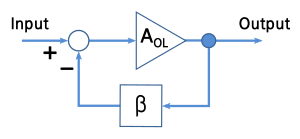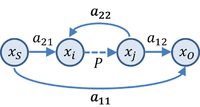负反馈放大器:修订间差异
Alexander Misel(留言 | 贡献) 小 →反馈和放大器种类: 内容扩充 |
Alexander Misel(留言 | 贡献) 内容扩充(翻译) |
||
| 第127行: | 第127行: | ||
|url=http://worldcat.org/isbn/0-387-25746-2}} |
|url=http://worldcat.org/isbn/0-387-25746-2}} |
||
</ref> |
</ref> |
||
== 信号流分析 == |
|||
一个主要理想化是将网络分割成两个''独立''的模块(即拥有各自独立确定的传递函数),一个简单的例子叫做“电路划分”,<ref name=Sahu> |
|||
{{cite book |title=VLSI Design |author= Partha Pratim Sahu |url=https://books.google.com/books?id=C37vAwAAQBAJ&pg=PA253 |chapter=§8.2 Partitioning |page=253 |isbn= 9781259029844 |publisher=McGraw Hill Education |year=2013 |quote=dividing a circuit into smaller parts ...[so]...the number of connections between parts is minimized}} |
|||
</ref>在此情况下就是指划分为一个正向放大模块和一个反馈模块。在实际的放大器中,信息流不是像这里展示的那样单向化的。<ref name=PalumboG> |
|||
{{cite book |author= Gaetano Palumbo, Salvatore Pennisi |title=Feedback Amplifiers: Theory and Design |quote=In real cases, unfortunately, blocks...cannot be assumed to be unidirectional. |url=https://books.google.com/books?id=VachCXS6BK8C&pg=PA66&dq=%22In+real+cases,+unfortunately,+blocks%22,%22cannot+be+assumed+to+be+unidirectional.%22&hl=en&sa=X&ei=lFSYVJyPIMrWoASEzYHIBw&ved=0CB8Q6AEwAA#v=onepage&q=%22In%20real%20cases%2C%20unfortunately%2C%20blocks%22%2C%22cannot%20be%20assumed%20to%20be%20unidirectional.%22&f=false |isbn= 9780792376439 |year=2002 |publisher=Springer Science & Business Media}} |
|||
</ref>通常这些模块被视为[[二端口网络]],允许包括双向的信息传递。<ref name=ChenW> |
|||
{{cite book |title=Feedback, Nonlinear, and Distributed Circuits |author=Wai-Kai Chen |url=https://books.google.com/books?id=W0dPWAaRx6kC&pg=SA1-PA3&dq=%22A+second+approach+to+feedback+network+analysis+involves+modeling+the+%22&hl=en&sa=X&ei=80mYVIa3LYjeoASPsYGwDA&ved=0CDkQ6AEwAg#v=onepage&q=%22A%20second%20approach%20to%20feedback%20network%20analysis%20involves%20modeling%20the%20%22&f=false |page=1-3 |chapter=§1.2 Methods of analysis |isbn=9781420058826 |year=2009 |publisher=CRC Press}} |
|||
</ref><ref name=Pederson> |
|||
{{cite book |chapter=§5.2 Feedback for a general amplifier |pages=105 ''ff'' |title=Analog Integrated Circuits for Communication: Principles, Simulation and Design |author=Donald O. Pederson, Kartikeya Mayaram |url=https://books.google.com/books?id=MBZugbZ1UM0C&pg=PA105 |year=2007 |publisher=Springer Science & Business Media |isbn=9780387680309}} |
|||
</ref>然而,把放大器转换成这种形式不是一个简单的事情,尤其是当涉及到的反馈并不是''全局的''(即直接从输出到输入)而是''局部的''(即反馈网络内涉及不与输入或输出端子重合的节点)。<ref name=Burgess> |
|||
{{cite web |work=Generalized feedback circuit analysis |author=Scott K Burgess & John Choma, Jr. |title=§6.3 Circuit partitioning |url=http://www.te.kmutnb.ac.th/~msn/nitiphat.pdf }} |
|||
</ref><ref name=Palumbo> |
|||
{{cite book |author= Gaetano Palumbo & Salvatore Pennisi |title=Feedback amplifiers: theory and design |
|||
|page=66 |year= 2002 |
|||
|publisher=Springer Science & Business Media |
|||
|isbn=9780792376439 |
|||
|url=https://books.google.com/books?id=VachCXS6BK8C&pg=PA66&dq=%22the+method+is+straightforwardly+applicable+to+only+those+circuits+that+implement+a%22+%22a+feedback+between+the+input+and+the+output%22+%22whereas+many+feedback+amplifiers+exploit+only+%22&hl=en&sa=X&ei=PjeWVKKrKYe1oQTW9IG4BA&ved=0CB8Q6AEwAA#v=onepage&q=%22the%20method%20is%20straightforwardly%20applicable%20to%20only%20those%20circuits%20that%20implement%20a%22%20%22a%20feedback%20between%20the%20input%20and%20the%20output%22%20%22whereas%20many%20feedback%20amplifiers%20exploit%20only%20%22&f=false}} |
|||
</ref> |
|||
[[File:Signal flow graph for feedback amplifier.png|thumb|200px |以关于两个内部变量 ''x<sub>j</sub>=Px<sub>i</sub>'' 的控制变量 ''P'' 为基础的负反馈放大电路的一种可能的信号流图。据 D.Amico ''et al.'' 绘图<ref name=Damico/> |
|||
]] |
|||
在这些更一般的情况下,放大器的分析更为直接,不用像图中划分成模块,而是使用基于[[信号流图|信号流分析]]的一些分析,如[[回归比|回归比法]]以及[[渐近增益模型]]。<ref name=Sarpeshkar>For an introduction, see {{cite book |title=Ultra Low Power Bioelectronics: Fundamentals, Biomedical Applications, and Bio-Inspired Systems |pages=240 ''ff'' |url=http://books.google.com/books?id=eYPBAyDRjOUC&pg=PA240 |chapter=Chapter 10: Return ratio analysis |author=Rahul Sarpeshkar |isbn=9781139485234 |year=2010 |publisher=Cambridge University Press}}</ref><ref name=Chen> |
|||
{{cite book |title=Circuit Analysis and Feedback Amplifier Theory |author=Wai-Kai Chen |url=https://books.google.com/books?id=ZlJM1OLDQx0C&pg=SA11-PA2 |pages=11-2 ''ff'' |chapter=§11.2 Methods of analysis |publisher=CRC Press |year=2005 |isbn= 9781420037272}} |
|||
</ref><ref name=Palumbo3> {{cite book |title=Feedback Amplifiers: Theory and Design |author= Gaetano Palumbo, Salvatore Pennisi |url=http://books.google.com/books?id=VachCXS6BK8C&pg=PA69 |pages= 69 ''ff'' |chapter=§3.3 The Rosenstark Method and §3.4 The Choma Method |isbn=9780792376439 |year=2002 |publisher=Springer Science & Business Media }} |
|||
</ref> Choma对信号流的方法评论道:<ref name=ChomaJr> |
|||
{{cite journal |author=J Choma, Jr |url=http://wenku.baidu.com/view/e046d9d528ea81c758f578c7.html |title=Signal flow analysis of feedback networks |journal=IEEE Trans Circuits & Systems |volume=37 |issue=4 |date=April 1990 |pages=455-463 |doi=10.1109/31.52748}} |
|||
</ref> |
|||
:"In contrast to block diagram and two-port approaches to the feedback network analysis problem, signal flow methods mandate no ''a priori'' assumptions as to the unilateral or bilateral properties of the open loop and feedback subcircuits. Moreover, they are not predicated on mutually independent open loop and feedback subcircuit transfer functions, and they do not require that feedback be implemented only globally. Indeed signal flow techniques do not even require explicit identification of the open loop and feedback subcircuits. Signal flow thus removes the detriments pervasive of conventional feedback network analyses but additionally, it proves to be computationally efficient as well." |
|||
== 反馈和放大器种类 == |
== 反馈和放大器种类 == |
||
2015年2月6日 (五) 05:17的版本

负反馈放大器(英語:negative feedback amplifier)是一种将输出信号按比例反馈回输入信号,从而达到控制的放大器。通过引入负反馈,放大器的性能,例如增益的稳定性、线性、频率响应、阶跃响应等,可以得到改善。此外,制造过程以及使用环境所造成的器件参数偏差对放大器性能的影响,可以通过引入负反馈缓解。由于以上优点,负反馈放大器在许多放大电路以及控制系统中有着广泛的应用。[1]
一个负反馈放大器具有负反馈模式的三个基本元素(如图1):一个开环增益为AOL的放大器、一个系数为β < 1的负反馈网络以及一个加减运算电路。上述三个元素只有放大器本身是必须的,在某些情况中,另外两个元素可能被省略。例如,在电压跟随器中,反馈网络以及求和电路并不必需。
概述
普遍地说,所有的电子设备都提供了一定的功率增益(例如真空管、双极性晶体管和场效应管),然而它们实际上大多属于非线性器件。负反馈可以通过降低增益来改善器件的线性。如果放大器没有正确地设计为负反馈,那么放大器的工作会变得不稳定,其产生的结果是一些不希望看到的行为,例如振荡。可以利用贝尔实验室的哈里·奈奎斯(Harry Nyquist)研究出的奈奎斯特稳定判据来研究反馈放大器的稳定性。
反馈放大器具有以下特点:[2]
优点:
缺点:
- 如果设计不周,可能会导致工作不稳定
- 放大器的实际增益降低
- 接入反馈的放大器(也称闭环放大器)的输入、输出阻抗与未接入反馈的放大器(也称开环放大器)的增益有关。
历史
负反馈放大器是由哈罗德·史蒂芬·布莱克(Harold Stephen Black)在他1927年8月2日前往贝尔实验室途中发明的。[3]布莱克当时正在努力研究降低电话通信中中继放大器信号失真的解决办法。当时,布莱克在他购买的《纽约时报》的一处空白记录下了他的灵感,[4]即一个类似图1的框图,以及一些推导的方程。[5]他随后在1928年8月8日向美国专利局提交了他的发明,之后耗费了8年时间才正式发表了这一专利。后来,布莱克写到:“导致如此严重的时间延迟的原因之一是这一概念与专利局的固有思维太过违背,以至于他们最初认为这套系统根本不可能工作。”[6]
经典反馈
降低增益
在下面的叙述中,接入反馈网络的放大器的闭环增益(closed-loop gain)Afb由放大器的开环增益(open-loop gain)AOL以及反馈系数β(决定输出量以何种比例反馈到输入端)共同决定。如图1,开环增益AOL大多数情况下是频率和电压的函数;反馈系数β由引入放大器的反馈网络形式决定。对于一个运算放大器,可以利用两个电阻构成分压器来为反馈网络设置介于0与1之间的反馈系数。也可以引入电容器和电感元件等具有特殊响应特性的元件来修改反馈网络的特性,使其来实现调频或者产生震荡特殊功能能够。引入反馈之后,电压放大器的增益可以由下面的过程推导。
当没有引入反馈时,输入电压V'in直接接在放大器的输入端,相应的输出电压是
现在假设接入一个反馈系数为β的反馈电路,那么,输出电压与输入电压与反馈电压的差值直接相关。这个差值作为接在放大器输入端的“输入电压”
将它代入第一个式中替换V'in,则
整理得
这样,反馈放大器的闭环增益Afb可以表达为
如果AOL >> 1,那么Afb ≈ 1 / β,并且等效的放大倍数(闭环增益)Afb,则可以通过改变反馈系数β来设置,由此改变反馈网络的性能(这样的反馈系统通常可以方便地设置),提高放大的线性以及稳定性。同时需要注意的是,如果β AOL = −1,则放大器的实际增益为无穷大,这样放大器将产生振荡,系统将变得不稳定。二者的乘积可以在奈奎斯特图中显示整个反馈网络的稳定性(也可以利用更为简单的波德图进行分析)。
L = β AOL在反馈分析中十分常见,有时也被称作是环路增益(loop gain)。( 1 + β AOL )在分析中也较为常见,被称为倒灵敏度因数(desensitivity factor)或改善因数(improvement factor)。
展宽频带

反馈网络也可以被用来展宽放大器的频带,但是增益相应地必须减少。[7]图2展示了上述的这一点,可以通过下面的方式理解此曲线图:当没有介入反馈网络,开环增益中只含有一个频率响应时间常数
这里,fC为放大器的截止频率。在这一例子中,fC = 104赫兹,零位频率时的增益为A0 = 105。上图显示了截止频率左侧,增益基本维持不变,不过当频率大于截止频率,增益会下降。当反馈网络被引入,则闭环增益的计算公式为
上面最后一式表示,反馈放大器仍然具有单一时间常数的行为方式,但是截止频率通过乘以( 1 + β A0 )得到了扩展,不过零位频率处的增益几乎以相同的倍数减少。这一特性被称作是增益带交换(gain-bandwidth tradeoff)。增益和带宽总是此消彼长。在图2中,( 1 + β A0 ) = 103,因此Afb(0)= 105 / 103 = 100 V/V,fC增加到104 × 103 = 107赫兹。
当放大器的开环增益具有多个极点,而非上述例子中所示的但极点,则引入反馈可以得到复极点(complex poles,具有实部和虚部两部分)。在双极点的情况中,反馈放大器在其截止频率附近得到其最佳的频率响应,且在阶跃响应中会发生信号过冲。当有多个极点时,反馈放大器会变得不稳定,并产生振荡。对于复杂情况较为详细的讨论,可以参阅相关专业的文献。[8]
信号流分析
一个主要理想化是将网络分割成两个独立的模块(即拥有各自独立确定的传递函数),一个简单的例子叫做“电路划分”,[9]在此情况下就是指划分为一个正向放大模块和一个反馈模块。在实际的放大器中,信息流不是像这里展示的那样单向化的。[10]通常这些模块被视为二端口网络,允许包括双向的信息传递。[11][12]然而,把放大器转换成这种形式不是一个简单的事情,尤其是当涉及到的反馈并不是全局的(即直接从输出到输入)而是局部的(即反馈网络内涉及不与输入或输出端子重合的节点)。[13][2]

在这些更一般的情况下,放大器的分析更为直接,不用像图中划分成模块,而是使用基于信号流分析的一些分析,如回归比法以及渐近增益模型。[15][16][17] Choma对信号流的方法评论道:[18]
- "In contrast to block diagram and two-port approaches to the feedback network analysis problem, signal flow methods mandate no a priori assumptions as to the unilateral or bilateral properties of the open loop and feedback subcircuits. Moreover, they are not predicated on mutually independent open loop and feedback subcircuit transfer functions, and they do not require that feedback be implemented only globally. Indeed signal flow techniques do not even require explicit identification of the open loop and feedback subcircuits. Signal flow thus removes the detriments pervasive of conventional feedback network analyses but additionally, it proves to be computationally efficient as well."
反馈和放大器种类
放大器使用电压或者电流作为其输入信号以及输出信号,因此总共有4中反馈接法。所有接法都是利用最简单的开环放大器引入反馈网络。不同的接法的设计目标有所不同。例如,一个运算放大器(电压放大)可以通过其他的接法来充当电流放大的功能。从一种类型到另一种类型的转换可以通过改变反馈网络的接法来实现,例如串联接法或并连接法,[19][20]见下表。
| 反馈放大器类型 | 输入连接 | 输出连接 | 理想反馈网络 | 两端口反馈 |
|---|---|---|---|---|
| 电流 | 并联 | 串联 | CCCS | g参数 |
| 互导 | 并联 | 并联 | CCVS | y参数 |
| 互阻 | 串联 | 串联 | VCCS | z参数 |
| 电压 | 串联 | 并联 | VCVS | h参数 |
反馈可以通过二端口网络来实现。有四种二端口网络,如何选择取决于反馈的类型。比如,对于一个电流反馈放大器,输出电流被取样,并与输入电流合并。于是,理想情况下的反馈是使用(输出)电流控制电流源(CCCS)工作的,使用二端口网络的不完美实现也必须包含一个CCCS,也就是说,反馈网络应当选择g参数二端口网络。
参考文献
- ^ Kuo, Benjamin C & Farid Golnaraghi. Automatic control systems Eighth edition. NY: Wiley. 2003: 46. ISBN 0471134767.
- ^ 2.0 2.1
Palumbo, Gaetano & Salvatore Pennisi. Feedback amplifiers: theory and design. Boston/Dordrecht/London: Kluwer Academic. 2002: 64. ISBN 0792376439.
引用错误:带有name属性“Palumbo”的
<ref>标签用不同内容定义了多次 - ^ . (PDF). [2005-10-24]. [失效連結]
- ^ Currently on display at Bell Laboratories in Mountainside, New Jersey
- ^ Waldhauer, Fred. Feedback. NY: Wiley. 1982: 3. ISBN 0471053198.
- ^ Black, Harold. Inventing the negative feedback amplifier. IEEE Spectrum. Dec. 1977.
- ^ RW Brodersen Analog circuit design: lectures on stability
- ^ Willy M. C. Sansen. Analog design essentials. New York; Berlin: Springer. 2006: §0513–§0533, p. 155–165. ISBN 0-387-25746-2.
- ^
Partha Pratim Sahu. §8.2 Partitioning. VLSI Design. McGraw Hill Education. 2013: 253. ISBN 9781259029844.
dividing a circuit into smaller parts ...[so]...the number of connections between parts is minimized
- ^
Gaetano Palumbo, Salvatore Pennisi. Feedback Amplifiers: Theory and Design. Springer Science & Business Media. 2002. ISBN 9780792376439.
In real cases, unfortunately, blocks...cannot be assumed to be unidirectional.
- ^ Wai-Kai Chen. §1.2 Methods of analysis. Feedback, Nonlinear, and Distributed Circuits. CRC Press. 2009: 1-3. ISBN 9781420058826.
- ^ Donald O. Pederson, Kartikeya Mayaram. §5.2 Feedback for a general amplifier. Analog Integrated Circuits for Communication: Principles, Simulation and Design. Springer Science & Business Media. 2007: 105 ff. ISBN 9780387680309.
- ^ Scott K Burgess & John Choma, Jr. §6.3 Circuit partitioning (PDF). Generalized feedback circuit analysis.
- ^ 引用错误:没有为名为
Damico的参考文献提供内容 - ^ For an introduction, see Rahul Sarpeshkar. Chapter 10: Return ratio analysis. Ultra Low Power Bioelectronics: Fundamentals, Biomedical Applications, and Bio-Inspired Systems. Cambridge University Press. 2010: 240 ff. ISBN 9781139485234.
- ^ Wai-Kai Chen. §11.2 Methods of analysis. Circuit Analysis and Feedback Amplifier Theory. CRC Press. 2005: 11–2 ff. ISBN 9781420037272.
- ^ Gaetano Palumbo, Salvatore Pennisi. §3.3 The Rosenstark Method and §3.4 The Choma Method. Feedback Amplifiers: Theory and Design. Springer Science & Business Media. 2002: 69 ff. ISBN 9780792376439.
- ^ J Choma, Jr. Signal flow analysis of feedback networks. IEEE Trans Circuits & Systems. April 1990, 37 (4): 455–463. doi:10.1109/31.52748.
- ^ Ashok K. Goel Feedback topologies
- ^ Zimmer T & Geoffroy D: Feedback amplifier










